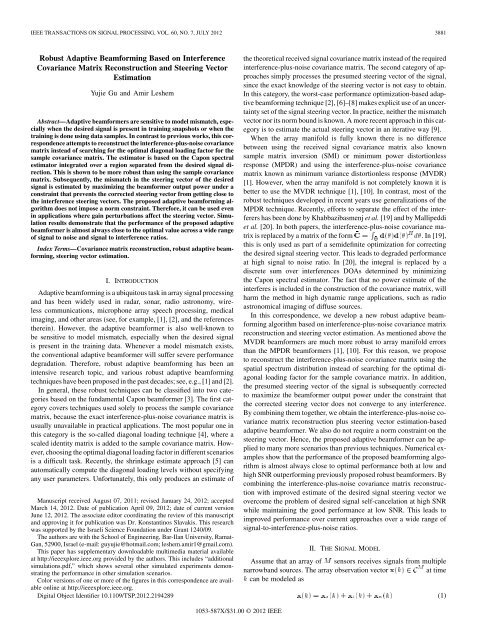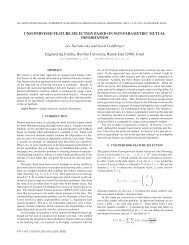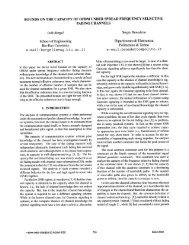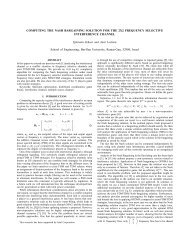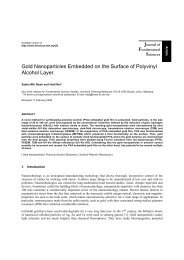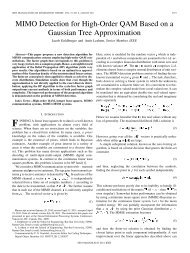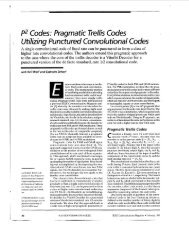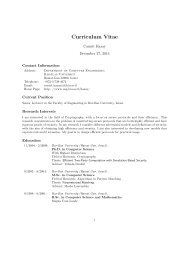x(k) - IEEE Xplore
x(k) - IEEE Xplore
x(k) - IEEE Xplore
Create successful ePaper yourself
Turn your PDF publications into a flip-book with our unique Google optimized e-Paper software.
<strong>IEEE</strong> TRANSACTIONS ON SIGNAL PROCESSING, VOL. 60, NO. 7, JULY 2012 3881<br />
Robust Adaptive Beamforming Based on Interference<br />
Covariance Matrix Reconstruction and Steering Vector<br />
Estimation<br />
Yujie Gu and Amir Leshem<br />
Abstract—Adaptive beamformers are sensitive to model mismatch, especially<br />
when the desired signal is present in training snapshots or when the<br />
training is done using data samples. In contrast to previous works, this correspondence<br />
attempts to reconstruct the interference-plus-noise covariance<br />
matrix instead of searching for the optimal diagonal loading factor for the<br />
sample covariance matrix. The estimator is based on the Capon spectral<br />
estimator integrated over a region separated from the desired signal direction.<br />
This is shown to be more robust than using the sample covariance<br />
matrix. Subsequently, the mismatch in the steering vector of the desired<br />
signal is estimated by maximizing the beamformer output power under a<br />
constraint that prevents the corrected steering vector from getting close to<br />
the interference steering vectors. The proposed adaptive beamforming algorithm<br />
does not impose a norm constraint. Therefore, it can be used even<br />
in applications where gain perturbations affect the steering vector. Simulation<br />
results demonstrate that the performance of the proposed adaptive<br />
beamformer is almost always close to the optimal value across a wide range<br />
of signal to noise and signal to interference ratios.<br />
Index Terms—Covariance matrix reconstruction, robust adaptive beamforming,<br />
steering vector estimation.<br />
I. INTRODUCTION<br />
Adaptive beamforming is a ubiquitous task in array signal processing<br />
and has been widely used in radar, sonar, radio astronomy, wireless<br />
communications, microphone array speech processing, medical<br />
imaging, and other areas (see, for example, [1], [2], and the references<br />
therein). However, the adaptive beamformer is also well-known to<br />
be sensitive to model mismatch, especially when the desired signal<br />
is present in the training data. Whenever a model mismatch exists,<br />
the conventional adaptive beamformer will suffer severe performance<br />
degradation. Therefore, robust adaptive beamforming has been an<br />
intensive research topic, and various robust adaptive beamforming<br />
techniques have been proposed in the past decades; see, e.g., [1] and [2].<br />
In general, these robust techniques can be classified into two categories<br />
based on the fundamental Capon beamformer [3]. The first category<br />
covers techniques used solely to process the sample covariance<br />
matrix, because the exact interference-plus-noise covariance matrix is<br />
usually unavailable in practical applications. The most popular one in<br />
this category is the so-called diagonal loading technique [4], where a<br />
scaled identity matrix is added to the sample covariance matrix. However,<br />
choosing the optimal diagonal loading factor in different scenarios<br />
is a difficult task. Recently, the shrinkage estimate approach [5] can<br />
automatically compute the diagonal loading levels without specifying<br />
any user parameters. Unfortunately, this only produces an estimate of<br />
Manuscript received August 07, 2011; revised January 24, 2012; accepted<br />
March 14, 2012. Date of publication April 09, 2012; date of current version<br />
June 12, 2012. The associate editor coordinating the review of this manuscript<br />
and approving it for publication was Dr. Konstantinos Slavakis. This research<br />
was supported by the Israeli Science Foundation under Grant 1240/09.<br />
The authors are with the School of Engineering, Bar-Ilan University, Ramat-<br />
Gan, 52900, Israel (e-mail: guyujie@hotmail.com; leshem.amir1@gmail.com).<br />
This paper has supplementary downloadable multimedia material available<br />
at http://ieeexplore.ieee.org provided by the authors. This includes “additional<br />
simulations.pdf,” which shows several other simulated experiments demonstrating<br />
the performance in other simulation scenarios.<br />
Color versions of one or more of the figures in this correspondence are available<br />
online at http://ieeexplore.ieee.org.<br />
Digital Object Identifier 10.1109/TSP.2012.2194289<br />
the theoretical received signal covariance matrix instead of the required<br />
interference-plus-noise covariance matrix. The second category of approaches<br />
simply processes the presumed steering vector of the signal,<br />
since the exact knowledge of the steering vector is not easy to obtain.<br />
In this category, the worst-case performance optimization-based adaptive<br />
beamforming technique [2], [6]–[8] makes explicit use of an uncertainty<br />
set of the signal steering vector. In practice, neither the mismatch<br />
vector nor its norm bound is known. A more recent approach in this category<br />
is to estimate the actual steering vector in an iterative way [9].<br />
When the array manifold is fully known there is no difference<br />
between using the received signal covariance matrix also known<br />
sample matrix inversion (SMI) or minimum power distortionless<br />
response (MPDR) and using the interference-plus-noise covariance<br />
matrix known as minimum variance distortionless response (MVDR)<br />
[1]. However, when the array manifold is not completely known it is<br />
better to use the MVDR technique [1], [10]. In contrast, most of the<br />
robust techniques developed in recent years use generalizations of the<br />
MPDR technique. Recently, efforts to separate the effect of the interferers<br />
has been done by Khabbazibasmenj et al. [19] and by Mallipeddi<br />
et al. [20]. In both papers, the interference-plus-noise covariance matrix<br />
is replaced by a matrix of the form C = 2 d()d()H d. In [19],<br />
this is only used as part of a semidefinite optimization for correcting<br />
the desired signal steering vector. This leads to degraded performance<br />
at high signal to noise ratio. In [20], the integral is replaced by a<br />
discrete sum over interferences DOAs determined by minimizing<br />
the Capon spectral estimator. The fact that no power estimate of the<br />
interferes is included in the construction of the covariance matrix, will<br />
harm the method in high dynamic range applications, such as radio<br />
astronomical imaging of diffuse sources.<br />
In this correspondence, we develop a new robust adaptive beamforming<br />
algorithm based on interference-plus-noise covariance matrix<br />
reconstruction and steering vector estimation. As mentioned above the<br />
MVDR beamformers are much more robust to array manifold errors<br />
than the MPDR beamformers [1], [10]. For this reason, we propose<br />
to reconstruct the interference-plus-noise covariance matrix using the<br />
spatial spectrum distribution instead of searching for the optimal diagonal<br />
loading factor for the sample covariance matrix. In addition,<br />
the presumed steering vector of the signal is subsequently corrected<br />
to maximize the beamformer output power under the constraint that<br />
the corrected steering vector does not converge to any interference.<br />
By combining them together, we obtain the interference-plus-noise covariance<br />
matrix reconstruction plus steering vector estimation-based<br />
adaptive beamformer. We also do not require a norm constraint on the<br />
steering vector. Hence, the proposed adaptive beamformer can be applied<br />
to many more scenarios than previous techniques. Numerical examples<br />
show that the performance of the proposed beamforming algorithm<br />
is almost always close to optimal performance both at low and<br />
high SNR outperforming previously proposed robust beamformers. By<br />
combining the interference-plus-noise covariance matrix reconstruction<br />
with improved estimate of the desired signal steering vector we<br />
overcome the problem of desired signal self-cancelation at high SNR<br />
while maintaining the good performance at low SNR. This leads to<br />
improved performance over current approaches over a wide range of<br />
signal-to-interference-plus-noise ratios.<br />
II. THE SIGNAL MODEL<br />
Assume that an array of M sensors receives signals from multiple<br />
narrowband sources. The array observation vector x(k) 2C M at time<br />
k can be modeled as<br />
x(k) =xs(k) +xi(k) +xn(k) (1)<br />
1053-587X/$31.00 © 2012 <strong>IEEE</strong>
3882 <strong>IEEE</strong> TRANSACTIONS ON SIGNAL PROCESSING, VOL. 60, NO. 7, JULY 2012<br />
where x s(k), xi(k), and xn(k) are the statistically independent components<br />
of the desired signal, interference, and noise, respectively. The<br />
desired signal can be written as x s (k) = as(k), where s(k) is the<br />
signal waveform and a 2C M is the steering vector associated with the<br />
desired signal.<br />
The adaptive beamformer output is given by<br />
y(k) =w H x(k) (2)<br />
where w =[w 1; 111;w M ] T 2C M is the beamformer weight vector<br />
and (1) T and (1) H denote the transpose and Hermitian transpose,<br />
respectively. The optimal beamformer weight vector w can be obtained<br />
by maximizing the output signal-to-interference-plus-noise<br />
ratio (SINR)<br />
SINR = 2 sjw H aj 2<br />
w H (3)<br />
R i+n w<br />
where 2 s is the signal power, R i+n = Ef(xi(k) +xn(k))(xi(k)+<br />
x n (k)) H g2C M2M is the interference-plus-noise covariance matrix,<br />
and Ef1g is the statistical expectation. The problem of maximizing (3)<br />
is mathematically equivalent to the MVDR beamforming problem<br />
min<br />
w wH R i+n w subject to w H a =1; (4)<br />
and more pronounced with increases in SNR. This explains the performance<br />
degradation of adaptive beamformers at high SNRs. Therefore,<br />
we will reconstruct the interference-plus-noise covariance matrix<br />
R i+n directly instead of searching for an optimal diagonal loading<br />
factor.<br />
Recall that R i+n =<br />
L l=1 2 l a( l )a H ( l )+0I, 2 where L is the<br />
number of interferers, l 2 is the power of the interference impinging<br />
from direction l and a( l ) is the corresponding steering vector, 0<br />
2<br />
is the noise power, and I is the identity matrix. Generally, the number<br />
of interferers, as well as their actual steering vectors and powers, are<br />
usually unknown. Moreover, the noise power is also unknown. Hence,<br />
in order to reconstruct the interference-plus-noise covariance matrix<br />
R i+n, we need to know the spatial spectrum distribution over all possible<br />
directions. In this correspondence, we use the Capon spatial spectrum<br />
estimator<br />
1<br />
^P () =<br />
d H () ^R 01 d()<br />
which is easy to obtain by substituting the Capon beamformer (5) back<br />
into the objective function of (4) with ^R. Aside from the Capon spatial<br />
spectrum estimator (6), there are other candidate spatial spectrum<br />
estimators [12]. Using the Capon spatial spectrum (6), the interference-plus-noise<br />
covariance matrix R i+n can be reconstructed as<br />
(6)<br />
and the solution is the MVDR beamformer, also referred to as the<br />
Capon beamformer,<br />
~R i+n =<br />
2<br />
^P ()d()d H ()d<br />
w opt =<br />
R01 i+n a<br />
a H Ri+n 01 a ; (5)<br />
which is a function of two factors R i+n and a.<br />
Since R i+n is unavailable even in signal-free applications,<br />
it is usually replaced by the sample covariance matrix ^R =<br />
1<br />
K<br />
K<br />
k=1 x(k)xH (k) with K snapshots, and the corresponding<br />
adaptive beamformer w SMI = ^R a<br />
a ^R a<br />
is called the sample matrix<br />
inversion (SMI) beamformer. Whenever the desired signal is<br />
present in the training samples, the SMI beamformer is in essence<br />
the MPDR beamformer [1] instead of the MVDR beamformer (4).<br />
As K increases, ^R converges to the theoretical covariance matrix<br />
R = saa 2 H + R i+n, and the corresponding SINR will approximate<br />
the optimal value as K ! 1 under stationary and ergodic<br />
assumptions. However, when the sample size K is small, there is a<br />
large gap between ^R and R. This gap is known to dramatically affect<br />
the performance, especially when the signal is present in the training<br />
samples [4], [11]. Furthermore, using ^R is much more sensitive to<br />
steering vector errors [1], [10].<br />
III. THE PROPOSED ALGORITHM<br />
In this section, a new adaptive beamforming algorithm is proposed.<br />
The basic idea is to reconstruct the interference-plus-noise covariance<br />
matrix first, and then estimate the steering vector of the desired signal.<br />
Therefore, the section is divided into two parts. First, we discuss the<br />
problem of reconstructing the interference-plus-noise covariance matrix.<br />
Then, we discuss the problem of estimating the signal steering<br />
vector.<br />
A. Interference-Plus-Noise Covariance Matrix Reconstruction<br />
Previous works on robust adaptive beamforming focused on finding<br />
the optimal diagonal loading factor for the sample covariance matrix<br />
^R, which inevitably resulted in performance degradation at high SNRs.<br />
This degradation is caused by the fact that the signal is always present<br />
in any kind of diagonal loading technique, and its effect becomes more<br />
=<br />
2<br />
d()d H ()<br />
d H () ^R 01 d (7)<br />
d()<br />
where d() is the steering vector associated with a hypothetical direction<br />
based on the known array structure (note that for the specific direction<br />
of the desired signal s a = d( s )), and 2 is the complement<br />
sector of 2. That is to say, 2 [ 2 covers the whole spatial domain,<br />
and 2 \ 2 is empty. Here, 2 is an angular sector in which the desired<br />
signal is located. The desired signal DOA s can be estimated, for example,<br />
using low-resolution direction finding methods, and the width<br />
of 2 is determined by the resolution of the array and the propagation<br />
environment. The main requirement is that the signal’s direction is in<br />
2 while the interferers are not. Hence, ~ R i+n collects all information<br />
on interference and noise in the out-of-sector 2. Consequently, the effect<br />
of the desired signal is removed from the reconstructed covariance<br />
matrix, as long as the desired signal’s direction is located inside 2.<br />
Before continuing, we would like to point out that, in the case of look<br />
direction mismatch, the estimate of the interference covariance matrix<br />
will be accurate, as long as the choice of 2 separates the interference<br />
from the desired signal. Similarly, in the case of local incoherent scattering<br />
effects, we expect the estimate to be very good. In the case of<br />
random steering vector errors, the effect of the random errors will be<br />
averaged over the various directions of the interference, therefore providing<br />
reasonable estimates of the interference-plus-noise covariance<br />
matrix. These observations provide at list an insight into the ad hoc estimate<br />
(7).<br />
Using ~ R i+n (7) in lieu of ^R in the SMI beamformer yields the interference-plus-noise<br />
covariance matrix reconstruction-based adaptive<br />
beamformer<br />
w Rec =<br />
~R 01<br />
i+n a<br />
a H ~ R 01<br />
i+n a (8)<br />
with the presumed steering vector a = d( s ).<br />
The computational complexity of the proposed algorithm is<br />
O(M 2 S), where S is the number of sampling points in 2 during the
<strong>IEEE</strong> TRANSACTIONS ON SIGNAL PROCESSING, VOL. 60, NO. 7, JULY 2012 3883<br />
TABLE I<br />
RECONSTRUCTION-PLUS-ESTIMATION-BASED ADAPTIVE BEAMFORMING ALGORITHM<br />
reconstruction of covariance matrix ~ R i+n (7). Typically, S M . The<br />
computational complexity of the simplest SMI beamformer is O(M 3 )<br />
mainly because of the matrix inversion operation [2]. Note, however,<br />
that if the spatial estimate in the whole region is desired, the SMI<br />
beamformer has complexity O(M 2 S) as well, assuming S M .<br />
Therefore, the simplified version of our beamformer, obtained by (8),<br />
has complexity slightly larger than the SMI but significantly more<br />
robust performance.<br />
In practice, the presumed steering vector a is usually different than<br />
the actual steering vector a. Therefore, in the following subsection, we<br />
will estimate the actual steering vector of the signal using the reconstructed<br />
covariance matrix ~ R i+n (7). This provides additional beamforming<br />
gain at the expense of increased computational complexity.<br />
B. Desired Signal Steering Vector Estimation<br />
The actual steering vector is difficult to obtain in practical applications<br />
by simply using the nominal DOA of the signal because of the<br />
complex propagation environment. Hence, here we will correct the presumed<br />
steering vector to maximize the beamformer output power.<br />
Substituting the Capon beamformer (5) with the reconstructed covariance<br />
matrix ~ R i+n (7) back into the objective function of (4), the<br />
beamformer output power is<br />
1<br />
~P (a) =<br />
a H R ~ (9)<br />
01<br />
i+n a<br />
which now is a function of the steering vector a not just the nominal<br />
DOA as in Section III-A. The steering vector a can be estimated by<br />
maximizing ~ P (a) or, equivalently, by minimizing the denominator of<br />
~P (a). In order to exclude the trivial solution a = 0, the presumed<br />
steering vector a should be utilized, which can be obtained from the<br />
nominal DOA of the signal with the known array structure. Specifically,<br />
the optimization problem of estimating a can be transformed to<br />
estimate the mismatch vector e as<br />
min e<br />
(a + e) H R ~ i+n 01 (a + e)<br />
subject to (a + e) H R ~ i+n (a + e) a H R ~ i+n a (10)<br />
where the inequality constraint is a single constraint expression of<br />
jc()(a + e) H d()j jc()a H d()j for all 2 2 with a weight<br />
coefficient c() = ^P (), which can be used to prevent the corrected<br />
steering vector a + e from converging to any interference located in 2. <br />
Here, the choice of c() is based on the fact that the interference with<br />
higher power should be more suppressed. Furthermore, the resulting<br />
constraint matrix is just the reconstructed covariance matrix. If c()<br />
is chosen to be independent of , e.g., c() = 1; 8 2 2, then the<br />
inequality constraint becomes (a + e ? ) H C(a + e ? ) a H Ca <br />
with the constraint matrix C = 2 d()d H ()d [9]. Basically, this<br />
constraint boils down to the requirement that the weighted average<br />
angle between the corrected steering vector and the vectors in the<br />
interference region will not increase relative to the average angle<br />
between the nominal steering vector and the same vectors.<br />
As we pointed out in [15], in some works on robust adaptive beamforming,<br />
the steering vector is assumed to have a fixed norm p M , i.e.,<br />
kak = p M . Although it does relax the requirement that the received<br />
signals from different sensors should have the same gain as the classical<br />
assumption in array signal processing, this norm constraint is still<br />
restrictive because in practical applications, e.g., in wireless communications,<br />
the gain perturbations of different sensors cannot be regarded<br />
as small as previously, and the norm constraint no longer holds. Hence,<br />
unlike [9], [13], this norm constraint will not be used in our formulation<br />
(10).<br />
The mismatch vector e can be further decomposed into two components.<br />
One denoted by e ? is orthogonal to a, and the other denoted by<br />
e k is parallel to a. e k does not affect the beamforming quality because<br />
it is a scaled copy of a and any scaling of the steering vector does not<br />
impact the SINR. Therefore, the optimization problem (10) can be further<br />
simplified to search for the orthogonal component e ? by solving<br />
the following problem:<br />
min<br />
e<br />
(a + e ? ) H ~ R 01<br />
i+n (a + e ?)<br />
subject to a H e ? =0;<br />
(a + e ? ) H R ~ i+n (a + e ? ) a H R ~ i+n a (11)<br />
where the equality constraint is introduced to maintain the orthogonality<br />
between e ? and a. Because ~ R i+n 0 is a positive-definite<br />
matrix, the optimization problem (11) is a feasible quadratically constrained<br />
quadratic programming (QCQP) problem and can be easily<br />
solved using convex optimization software, such as CVX [14].<br />
Except the two constraints in (11), we do not need any other constraint.<br />
Hence, the additional eigendecomposition of the covariance<br />
matrix in [9], [13], [15] is effectively avoided in our approach. Considering<br />
that the objective of the beamformer design is to maximize<br />
SINR (3), the presumed steering vector a is corrected as<br />
~a = a + e ? (12)<br />
as soon as the problem (11) is solved. Here, we emphasize once again<br />
that the normalization operation p k~ak<br />
M<br />
=1is unnecessary, because we<br />
do not know a priori the norm of the actual steering vector and more importantly,<br />
this normalization operation does not affect the beamformer<br />
output SINR at all. Hence, we can eliminate the iteration operation in<br />
[9] and [13].<br />
Up to now, both the reconstructed interference-plus-noise covariance<br />
matrix R ~ i+n (7) and the corrected steering vector ~a (12) have<br />
been obtained. Substituting them back into the Capon beamformer (5)<br />
together, the adaptive beamformer based on covariance matrix reconstruction<br />
plus steering vector estimation can be computed as<br />
~R i+n 01<br />
w Rec0Est =<br />
~a<br />
~a H R ~ : (13)<br />
i+n 01 ~a<br />
The reconstruction-plus-estimation-based adaptive beamforming algorithm<br />
is summarized in Table I. The computational complexity in<br />
this case is dominated by the solution of the QCQP problem, which is<br />
O(M 3:5 ). This makes the two step algorithm equivalent to other robust<br />
beamforming algorithms.
3884 <strong>IEEE</strong> TRANSACTIONS ON SIGNAL PROCESSING, VOL. 60, NO. 7, JULY 2012<br />
Fig. 1.<br />
First example. (a) Output SINR versus input SNR; (b) deviations from optimal SINR versus SNR; (c) output SINR versus number of snapshots.<br />
IV. SIMULATION<br />
In our simulations, a uniform linear array (ULA) with M = 10<br />
omnidirectional sensors spaced a half wavelength apart is used. The<br />
additive noise is modeled as a complex circularly symmetric Gaussian<br />
zero-mean spatially and temporally white process. Two interfering<br />
sources are assumed to have DOAs 050 and 020 , respectively.<br />
The interference-to-noise ratio (INR) in each sensor is equal to 30 dB.<br />
The desired signal is assumed to be a plane-wave from the presumed<br />
direction s = 5 . When comparing the performance of the adaptive<br />
beamforming algorithms in terms of the number of samples, the<br />
SNR in each sensor is set to be fixed at 20 dB. In the performance<br />
comparison of mean output SINR versus the input SNR, the number of<br />
snapshots is fixed to be K =30. For each scenario, 200 Monte-Carlo<br />
runs are performed.<br />
The proposed beamformers (8) and (13) are compared to the<br />
eigenspace-based beamformer [16], the worst-case-based beamformer<br />
[6], the sequential quadratic programming (SQP)-based beamformer<br />
[9], the shrinkage estimation-based beamformer [5], and the iterative<br />
adaptive approach (IAA) beamformer [17]. In the SQP-based beamformer<br />
and the proposed beamformers, the possible angular sector of<br />
the desired signal is set to be 2 = [0 ; 10 ] and the corresponding<br />
out-of-sector is 2 = [090 ; 0 ) [ (10 ; 90 ]. The value = 0:1<br />
and six dominant eigenvectors of the matrix C = 2<br />
d()d H ()d<br />
are used in the SQP-based beamformer, and the value = 0:3 M<br />
is used for the worst-case-based beamformer. The eigenspace-based<br />
beamformer is assumed to know the number of interference sources.<br />
The optimal SINR (3) is also shown in all figures, which is calculated<br />
from the exact interference-plus-noise covariance matrix and the<br />
actual desired signal steering vector. CVX software [14] was used to<br />
solve these convex optimization problems. It should be emphasized<br />
that in all simulations, the actual steering vector a was not normalized<br />
so that a H a = M was not always satisfied.<br />
A. Example 1: Random Signal and Interference Look<br />
Direction Mismatch<br />
In the first example, a scenario with random look direction mismatch<br />
is considered. The random DOA mismatch of both the desired signal<br />
and the interferers are uniformly distributed in [04 ; 4 ]. That is to<br />
say, the DOA of the signal is uniformly distributed in [1 ; 9 ], and the<br />
DOAs of two interferences are uniformly distributed in [054 ; 046 ]<br />
and [024 ; 016 ], respectively. Here, the random DOAs of the signal<br />
and the interferences change from run to run but remain fixed from<br />
snapshot to snapshot. Fig. 1(a) compares the output SINR of the aforementioned<br />
methods versus the SNR. Because the performance difference<br />
is not straightforward especially at low SNRs, their deviations<br />
from the optimal SINR are compared in Fig. 1(b). In Fig. 1(c), the<br />
output SINRs for the tested methods are illustrated against the number<br />
of snapshots K. It can be seen from these figures that the performances<br />
of the proposed beamformers are always close to the optimal SINR in a<br />
large range from 030 to 50 dB. Furthermore, the proposed algorithms<br />
enjoy much faster convergence rates than others. The signal power is<br />
100 times the interference power in the case of SNR = 50 dB, which<br />
can be used to illustrate the situation when the signal-to-interference<br />
ratio (SIR) approaches 1.<br />
B. Example 2: Signal Spatial Signature Mismatch due to Incoherent<br />
Local Scattering<br />
A distributed or incoherent scattered source arises mainly from the<br />
multipath scattering effects caused by the presence of local scatterers,<br />
which is also commonplace in radar, sonar, radio astronomy and wireless<br />
communications applications. In this example, we assume incoherent<br />
local scattering of the signal. The signal is assumed to have a<br />
time-varying spatial signature that is different for each data snapshot<br />
and is modeled as<br />
a(k) =s 0(k)a +<br />
4<br />
p=1<br />
s p(k)d( p) (14)<br />
where s 0(k) and s p(k);p =1, 2, 3, 4 are independently and identically<br />
distributed (i.i.d.) zero-mean complex Gaussian random variables independently<br />
drawn from a random generator N (0; 1). The DOAs p;p=<br />
1, 2, 3, 4 are independently normally distributed in N ( s ; 4 ) in each<br />
simulation run. It should be pointed out that the beamformers are implemented<br />
in a block adaptive manner, which means that p changes<br />
from run to run while remains fixed from snapshot to snapshot. At the<br />
same time, the random variables s 0 (k) and s p (k) change not only from<br />
run to run but also from snapshot to snapshot. This corresponds to the<br />
case of incoherent local scattering [18]. In this scenario, the norm of<br />
the desired signal steering vector kak keeps changing from snapshot<br />
to snapshot. Due to the fact that the signal covariance matrix R s is no<br />
longer a rank-one matrix in this scenario, the output SINR should be<br />
rewritten as [11]<br />
SINR =<br />
wH R sw<br />
w H R i+nw<br />
instead of (3). The SINR (15) is maximized by [11]<br />
(15)<br />
w opt = P R 01<br />
i+nR s (16)<br />
where Pf1g stands for the principal eigenvector of a matrix. It can be<br />
seen from Fig. 2 that although there are some performance degradations
<strong>IEEE</strong> TRANSACTIONS ON SIGNAL PROCESSING, VOL. 60, NO. 7, JULY 2012 3885<br />
Fig. 2. Second example. (a) Output SINR versus input SNR; (b) deviations from optimal SINR versus SNR; (c) output SINR versus number of snapshots.<br />
with the increase in SNR compared to the optimal value, the proposed<br />
beamforming algorithms still outperform the other methods tested.<br />
The simulation results clearly demonstrate that the proposed beamformers<br />
outperform all other existing beamformers, and achieve performance<br />
that is consistently close to the optimal SINR for all values<br />
of SNR from 030 to 50 dB, which illustrates its high dynamic range.<br />
Specifically,<br />
SINR Rec0Est 'kak 2 SNR: (17)<br />
In the first example, the actual steering vector satisfies the norm constraint<br />
and hence, the array output SINRs are approximately 10 dB<br />
higher than the SNR. By contrast, in the second example, the norm of<br />
the actual steering vector is magnified due to the effect of incoherent<br />
local scattering and the output SINRs of all tested beamformers are<br />
subsequently scaled up.<br />
V. CONCLUSION<br />
In this correspondence, we proposed an effective adaptive beamforming<br />
algorithm, which is robust not only to covariance matrix uncertainty<br />
but also to steering vector mismatch. With the knowledge of the<br />
presumed DOA of the desired signal, the interference-plus-noise covariance<br />
matrix can be reconstructed based on the spatial spectrum distribution,<br />
which provides a quasi signal-free environment. Based on the<br />
reconstructed covariance matrix, the presumed steering vector of the<br />
signal is corrected to maximize the array output power. In contrast to<br />
other algorithms, the proposed adaptive beamforming algorithm does<br />
not need the norm constraint of the steering vector, which thus widely<br />
extends its applicability. The simulation results demonstrate that the<br />
performance of proposed adaptive beamformer is almost always close<br />
to optimal in a very large range of SNR.<br />
ACKNOWLEDGMENT<br />
The authors would like to thank the associate editor Prof. Salvakis<br />
and the anonymous reviewers for their helpful comments and<br />
suggestions.<br />
REFERENCES<br />
[1] H. L. Van Trees, Detection, Estimation, and Modulation Theory, Part<br />
IV: Optimum Array Processing. New York: Wiley, 2002.<br />
[2] Robust Adaptive Beamforming, J. Li and P. Stocia, Eds. New York:<br />
Wiley, 2005.<br />
[3] J. Capon, “High-resolution frequency-wavenumber spectrum analysis,”<br />
Proc. <strong>IEEE</strong>, vol. 57, no. 8, pp. 1408–1418, Aug. 1969.<br />
[4] H. Cox, R. M. Zeskind, and M. H. Owen, “Robust adaptive beamforming,”<br />
<strong>IEEE</strong> Trans. Acoust., Speech, Signal Process., vol. ASSP-35,<br />
no. 10, pp. 1365–1376, Oct. 1987.<br />
[5] P. Stoica, J. Li, X. Zhu, and J. R. Guerci, “On using a priori knowledge<br />
in space-time adaptive processing,” <strong>IEEE</strong> Trans. Signal Process., vol.<br />
56, no. 6, pp. 2598–2602, Jun. 2008.<br />
[6] S. A. Vorobyov, A. B. Gershman, and Z. Q. Luo, “Robust adaptive<br />
beamforming using worst-case performance optimization: A solution<br />
to the signal mismatch problem,” <strong>IEEE</strong> Trans. Signal Process., vol. 51,<br />
no. 2, pp. 313–324, Feb. 2003.<br />
[7] J. Li, P. Stoica, and Z. Wang, “On robust Capon beamforming and<br />
diagonal loading,” <strong>IEEE</strong> Trans. Signal Process., vol. 51, no. 7, pp.<br />
1702–1715, Jul. 2003.<br />
[8] R. G. Lorenz and S. P. Boyd, “Robust minimum variance beamforming,”<br />
<strong>IEEE</strong> Trans. Signal Process., vol. 53, no. 5, pp. 1684–1696,<br />
May 2005.<br />
[9] A. Hassanien, S. Vorobyov, and K. M. Wong, “Robust adaptive beamforming<br />
using sequential quadratic programming: An iterative solution<br />
to the mismatch problem,” <strong>IEEE</strong> Signal Process. Lett., vol. 15, pp.<br />
733–736, 2008.<br />
[10] L. Ehrenberg, S. Gannot, A. Leshem, and E. Zehavi, “Sensitivity<br />
analysis of MVDR and MPDR beamformers,” presented at the <strong>IEEE</strong><br />
26th Convention of Electr. Electron. Eng. in Israel, Eliat, Israel, Nov.<br />
2010.<br />
[11] A. B. Gershman, “Robust adaptive beamforming in sensor arrays,” Int.<br />
J. Electron. Commun., vol. 53, pp. 305–314, Dec. 1999.<br />
[12] P. Stoica and R. L. Moses, Introduction to Spectral Analysis. Englewood<br />
Cliffs, NJ: Prentice-Hall, 1997.<br />
[13] Y. J. Gu, W. P. Zhu, and M. N. S. Swamy, “Adaptive beamforming<br />
with joint robustness against covariance matrix uncertainty and signal<br />
steering vector mismatch,” Electron. Lett., vol. 46, no. 1, pp. 86–88,<br />
Jan. 2010.<br />
[14] M. Grant, S. Boyd, and Y. Y. Ye, CVX: MATLAB software for disciplined<br />
convex programming, Feb. 2007 [Online]. Available: http://<br />
www.stanford.edu/boyd/cvx/V.1.0RC3<br />
[15] Y. Gu and A. Leshem, “Robust adaptive beamforming based on jointly<br />
estimating covariance matrix and steering vector,” in Proc. Int. Conf.<br />
Acoust., Speech, Signal Process. (ICASSP), Prague, Czech Republic,<br />
May 2011, pp. 2640–2643.<br />
[16] D. D. Feldman and L. J. Griffiths, “A projection approach to robust<br />
adaptive beamforming,” <strong>IEEE</strong> Trans. Signal Process., vol. 42, no. 4,<br />
pp. 867–876, Apr. 1994.<br />
[17] T. Yardibi, J. Li, P. Stoica, M. Xue, and A. B. Baggeroer, “Source<br />
localization and sensing: A nonparametric iterative adaptive approach<br />
based on weighted least squares,” <strong>IEEE</strong> Trans. Aerosp. Electron. Syst.,<br />
vol. 46, no. 1, pp. 425–443, Jan. 2010.<br />
[18] O. Besson and P. Stoica, “Decoupled estimation of DOA and angular<br />
spread for a spatially distributed source,” <strong>IEEE</strong> Trans. Signal Process.,<br />
vol. 48, no. 7, pp. 1872–1882, Jul. 2000.<br />
[19] A. Khabbazibasmenj, S. A. Vorobyov, and A. Hassanien, “Robust<br />
adaptive beamforming via estimating steering vector based on<br />
semidefinite relaxation,” in Proc. 44th Annu. Asilomar Conf. Signals,<br />
Syst.s, Comput., Pacific Grove, CA, Nov. 7–10, 2010, pp.<br />
1102–1106.<br />
[20] R. Mallipeddi, J. P. Lie, P. N. Suganthan, S. G. Razul, and C. M. S. See,<br />
“Robust adaptive beamforming based on covariance matrix reconstruction<br />
for look direction mismatch,” Progr. Electromagn. Res.—Lett., vol.<br />
25, pp. 37–46, 2011.


